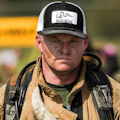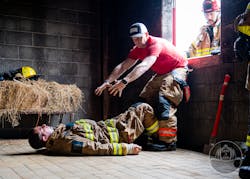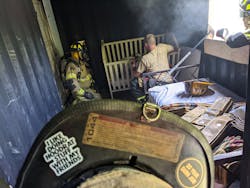Training is education. The quicker that we embrace that principle, the quicker that we’ll pass on the information to the student.
If we teach in a sustained rhythm, if we coach, if we are patient, we will produce better students. If we teach the language, if we work the imagination, if we are good examples, we will produce better students.
All of these items should be common knowledge, but they have tended to fall off and be replaced with unrealistic stress, quick assumptions and bad teachers. If we have actual instructors do all of these things, we will we produce better students.
A proper progression
When teaching a skill or technique, it must be taught at the basic level and then progressed forward in a sustained rhythm. A simple metaphor for this is learning to drive. The first time that you sat in the driver’s seat of an automobile, Dale Earnhardt Jr. didn’t give you a 15-minute lesson and then send you off to start at the Daytona 500.
Begin with an objective goal in mind: “I want the students to be able to search a bedroom during a live fire evolution in less than one minute and remove one victim.”
The first step toward that goal must be searching in little to no bunker gear in a clear room—quite possibly the same room that they will search later. Then progress to SCBA, then breathing air, adding a victim and adding theatrical smoke. Then—and only once they show proficiency—move to live fire.
Every time that you add something, add a repetition. Speed comes last.
If that sounds like a substantial amount of time with a lot of reps that’s because it is. Through repetition you build a skill set. Remember, no one goes from crawling to sprinting the 40-yard dash. Training must be kept in the same fashion. If the skill becomes repetitive, then the mind has accepted and understood. Thus, the students then are ready for the next training increase.
Keep this moving forward until, finally, they can do it in the worst conditions.
If at some point a mistake is made—and students should make mistakes—pause, correct and repeat. This is proper correction. If they can’t get it right without SCBA and stress, how can you expect them to get it right under extreme conditions?Smart coaching
A good portion of training should be coaching. This requires investing time with the students and understanding how they learn. The time and place for stress and testing will come.
There’s a good chance that your students don’t learn the same way that you do, and the learning process should be focused on development. Confirming that they understand through back-and-forth conversation and small increases allows that development to happen.
As an instructor, you must provide the guidance that’s needed to the complete the task correctly. Remember, it’s a learning environment. Coach along the way as you move through the steps. Positive guidance will prove to be beneficial: Students tend to listen more and to ask questions. Keep this in mind as you coach through the steps.
In this vein is our repeated use of the precursor, “Watch what I am about to demonstrate very closely and save your questions for the end. The demonstration will answer most of them.” However, the instructor must be patient. If we fail as instructors to give the time and put forth the work that it takes for skill proficiency, we do great harm in the long run.
By slowing down and front-loading the training, scenarios can be more realistic and more difficult. Rushing doesn’t save time; it wastes it. The student must demonstrate proficiency to move on. The assumption that watching other students complete the task is the same as completing the task doesn’t work. Students must do it with their own hands. Watching someone bench 350 lbs. isn’t the same as doing it.
Take the time to take the time. In the end, it isn’t the firefighter who benefits from that; it’s the public. That’s why we train in the first place: to give the public the best that we have.
Common terminology
The language that you use must be consistent. Again, this takes practice on the instructor’s part.
Every time that a term is used, the brain looks for it for understanding. “Pumper” and “engine” might mean the same to you, but they don’t to the Day One student.
Instructors should spend time together before the class to develop a common language. This is easy if the instructors are from the same department or region but quickly can unravel if not planned for accordingly.
This common language is exactly the same as the English language. Of course, there are different dialects, depending on your location in the country. You must adapt to that and be consistent in your class.
Realistic training evolutions
The imagination can be a wonderful tool in training. However, it doesn’t take the place of actual physical tools. Students and instructors easily can imagine different things.
Pictures, sounds and videos can begin to zone in that imagination. Theatrical smoke works very well when used correctly. I have seen some of the best instructors in the country add things, such as smells and flame-style lightbulbs, to increase the realism.
Build the training evolution to include common items that firefighters will see on the fireground. This should be regional to the training scenario. Kitchen tables belong in the kitchen; vacant rooms are in vacant houses, etc.
The environment should seem as realistic as possible and make sense. A child’s room should look and feel like a child’s room. This all seems very simple, but think of the calls that you make now and who most likely is to be trapped by fire. The elderly and disabled are very high on the list, but how many fire training scenarios have you completed that addressed it. For example, have you ever seen a walker or wheelchair in a training building? If not, find one.
If you teach firefighters to look around on EMS runs, in their own homes and while buildings are being constructed in their district, you can begin to create the situational awareness that’s needed.Legitimacy
We as instructors must be good examples to our students. How would you respond to a dentist who has bad teeth or a personal trainer who is out of shape?
You must be able to do the tasks that you require of your students. This includes the simplest of items: gear drills, masking up and SCBA use. This gives great credibility to your teaching techniques and requirements. This doesn’t mean that the 30-year veteran instructor who has a bad back and bad knees must demonstrate the tripod position, but someone has to.
Also, there’s a time for pushing the envelope with stress. If conducted in a methodical, organized manner, it can do amazing things for the student.
This also means that instructors must understand that they don’t know everything. They can’t. Thus, when presented with something that they don’t know, they must admit it. Then find the answer and give it back to the student. We constantly say, “I don’t know everything,” but never actually say, “I don’t know,” when presented with something that you don’t. If the instructor instead muddles through with the fastest answer that comes to mind, the wrong thing often can end up being taught. What happens when the student uses that incorrect information?
The goal of training is to produce better students. You can’t do that by lying to them.
Finally, instructors should look and act professionally. This includes appearance and demeanor.
The goal: a better student
The title “instructor” is gained easily in the American fire service. Sometimes, these are well-seasoned, highly capable individuals who have the skills and abilities to earn that title. Other times, the individuals are just the next one up.
As good servants to our profession, we must maintain a constant vigilance of this. When instructors say something, how do they know that statement to be true? Where did they learn it? How did the person who taught them acquire that knowledge?
It’s OK to ask these questions. We must pass on vetted, tried-and-true practices while allowing for attempts at new concepts.
The goal of training should be to produce a better student. This takes time. It must have the planning and preparation done ahead of time. Professional teachers use lesson plans, progress checks and goals. You should do the same.
Hold your students to a high standard and hold instructors to an even higher one. I have had the great fortune to see some of the best fire service instructors operate. They yelled when the time was right, they coached whenever possible, and they set high standards for themselves.
Your job as a fire service instructor is to educate. Be a mentor, be a friend, and help. Do your job and help the next generation be better than the generation that preceded it.
About the Author

Devin Craig
Devin Craig has been in the fire service for more than 20 years. He is a captain with Montgomery County, TX, Emergency Services District #2/Montgomery Fire Department and spent several years working for the Recruit Division of Texas A&M Engineering Extension Service. Craig holds the Instructor 3 and Fire Officer 4 certifications from the Texas Commission on Fire Protection as well as numerous others. He is the co-owner of Train or Die LLC, which is a fire service training company, and of Georgia Smoke Diver #987.


